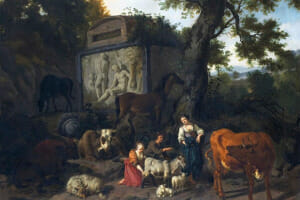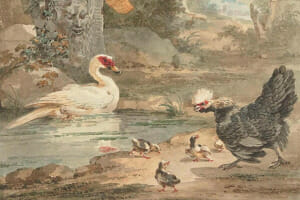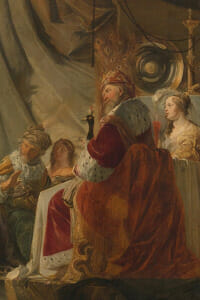Symbolism in Antigone: The Use of Imagery and Motifs in the Play
 Sophocles used symbolism in Antigone to carry out deeper messages that were not obvious to the audience. These symbols gave weight to the play and added more dramatic elements to the story by expressing complex ideas in simple images, metaphors and motifs. This article will explore the various types of symbolism in Antigone and how they help to drive the plot of the story.
Sophocles used symbolism in Antigone to carry out deeper messages that were not obvious to the audience. These symbols gave weight to the play and added more dramatic elements to the story by expressing complex ideas in simple images, metaphors and motifs. This article will explore the various types of symbolism in Antigone and how they help to drive the plot of the story.
We will also look at specific cases of Symbolism in the tragic play.
Symbolism in Antigone: A Study Guide
There are several instances in the play where symbols are artistically used to represent ideas and emotions. This study guide will help you identify some examples of symbolism, how they are used and what they represent. This is by no means exhaustive but will cover the major symbols and their meanings.
The Stone Tomb Symbolism in Antigone
The stone tomb is a symbol that represents Creon’s quest to restore law and order by giving a punishment that fits the crime. Creon constructed the stone tomb to punish Antigone by burying her alive for disobeying his orders.
Antigone had defied the King’s orders not to bury her brother Polyneices and her actions proved that she was more loyal to the dead than the living. This, of course, angers King Creon who thinks that the living deserved more honor than the dead.
Since Antigone went against his decrees to honor the dead, Creon feels that burying her alive in the stone tomb befits her crime. After all, Antigone has chosen to side with the dead so it is only fit to allow her to continue on that path.
In Creon’s own words, “She shall be deprived of her sojourn in the light“, meaning Antigone’s rebellious actions would receive death as punishment. The decision to bury Antigone alive, however, backfires when Creon ends up being indirectly responsible for both his wife and son’s death.
In addition, the stone tomb signifies Creon’s rebellion against the gods. Zeus had decreed that the dead should be given a befitting burial so they can go on to rest. Refusing to bury the dead will make them wandering souls and was a crime against Zeus. However, Creon’s heart of stone leads him to disobey the gods and this costs him dearly at the end of the play.
Bird Symbolism in Antigone
 Another major imagery in Antigone is the use of birds.
Another major imagery in Antigone is the use of birds.
Polyneices is described as a huge vicious eagle that causes terror and disaster in the land of Thebes.
This imagery represents the rebellious and wicked nature of Polyneices when he fights his brother and wreaks havoc on the city of Thebes. Ironically, birds feed on Polyneices (the vicious eagle) when he died and his body was left unburied under Creon’s orders.
Nonetheless, Antigone’s constant effort to see the body of Polyneices leads the sentry to describe her like a mother bird hovering over the corpse of Polyneices. In this symbolism, Antigone’s relentless care for her brother is compared to the maternal care of a mother bird who will do anything to protect her children including giving up her life.
However, the most pronounced use of bird symbolism in the story comes from the blind seer Teiresias. Teiresias had the gift of telling the future by observing the behavior of birds. When Creon refuses to bury Polyneices, the seer tells him that the birds are fighting each other symbolizing the chaos that Creon’s decision has caused.
Additionally, Tiresias informs Creon that the birds have refused to predict the future because they are drunk on Polyneices’ blood. This symbolizes how Creon’s orders have silenced the gods. The seer then tells Creon that the birds have desecrated the altars of Thebes by pooping all over them symbolizing Creon’s rebellion against the gods by refusing to give Polyneices a befitting burial.
Creon’s Symbole in Antigone
Creon represents a tyrant King who cares little about honoring the gods and preserving humanity. He is an autocratic leader who is his own god and does whatever he wishes and deems fit for society. Creon has his vision of society and does everything in his power to make Thebes follow his vision with little regard for the gods.
As a tyrant, Creon refuses to listen to Antigone’s constant plea and does not consider the feelings of his son Haemon. Creon is full of ambition and pride which eventually leads to his fall at the end of the play.
The Symbolism of Creon in Anouilh’s Adaptation
However, in his adaptation of Antigone, Jean Anouilh, a French playwright, presents Creon in a way that makes the audience sympathize with him. Though Anouilh’s Creon is a dictator who craves absolute power, he is presented as a gentleman who speaks delicately.
For instance, when Antigone was brought in after she had attempted to bury her brother, Creon speaks to her in a gentle and advising tone. Creon in Anouilh’s adaptation represents the gentle and wise King who rules his Kingdom with wisdom rather than brute force.
In Anouilh’s adaptation, Creon gives his reason for not burying Polynices by giving a story that was contrary to what happened in Sophocles’ play. According to him, the two brothers were petty thieves who died a drastic death that left their bodies unrecognizable.
Thus, he did not know who to honor and who to bury so he gave one a befitting burial and left the other to rot. This decision by Creon united Thebes because if the citizens knew the true events there would have been conflicted in the land.
Other Symbols in Antigone and their Meanings
One of the motifs in Antigone is dirt which symbolizes Antigone’s rebellion against the King’s rule and her loyalty to her family. It also represents her bravery even when faced with imminent death. All she did was scoop a handful of dust on Polyneices’ body and it was enough to cause her death. The dust also symbolizes man’s final destination because no matter how long she or Creon or anyone lived they will eventually become dust.
For Creon, money symbolizes corruption as he believes the sentries who guarded Polyneices’ bodies took bribes to perform the burial themselves. However, contrary to Creon’s accusations, the body of Polyneices was buried by the meek Antigone whose love for her family superseded her fear of Creon.
Creon could just not fathom how someone could bypass his sentries and break the law thus he believed either they took bribes to bury the body or turned a blind eye. The same was said of Teiresias later in the play when Creon accused the blind seer of being motivated by money.
The metaphors in Antigone used to represent money were brass and gold. When Creon accuses Teiresias of being motivated by money (gold). The blind seer also accuses Creon of valuing brass, symbolizing worthless ideals as compared to gold which was a symbol of great standards.
Teiresias’ statement means that Creon has sacrificed better principles for his vain pride and empty laws. He chose to disobey the gods and desecrate the entire Thebes for his laws that only served to fan his ego.
FAQ
What Does Eurydice’s Death Symbolize in Antigone?
Her death symbolizes the final straw that breaks Creon’s back as he becomes alone. Eurydice’s death is the last lesson for Creon as he realizes how his decisions have caused needless deaths. So it’s one of the minor themes in Antigone is Eurydice’s death. Eurydice, the wife of Creon and mother of Haemon, kills herself after she learns of the death of her son Haemon.
What Is the Symbolism of the Setting of Antigone?
The setting of Antigone is the palace of Thebes which represents the tragedy and gloom that the city of Thebes had witnessed since Oedipus Rex. That was where Jocasta killed herself and Oedipus gouged out his eyes.
Eteocles and Polyneices also fought over the throne while Eurydice also committed suicide in the palace. The palace was a scene of curses, suspicions, arguments and strife. Therefore, the palace in Antigone is a symbol of the tragedy that befell Oedipus’ family — from King Laius to Antigone.
Conclusion
 So far, we’ve been reading the meaning of symbols and motifs in Antigone. Here is a recap of all that we’ve discovered:
So far, we’ve been reading the meaning of symbols and motifs in Antigone. Here is a recap of all that we’ve discovered:
- The main symbol is the stone tomb which represents Antigone’s loyalty to her family and her gods and Creon’s disregard for the deities and insisting on following through with his laws.
- The birds in the play have several meanings including symbolizing Antigone’s love for her brother, the decaying state of Thebes and the vicious nature of Polyneices.
- Creon represents a tyrant king whose word is the law and won’t allow anyone to dissuade him even if the law offends the gods.
- Other symbols in the play include money which Creon sees as a force of corruption, brass which symbolizes Creon’s worthless ideals and gold which represents quality standards set by the gods.
- The palace in Antigone symbolizes the tragedy that has befallen the family of Oedipus right from his father to his children including his brother Creon.
Symbols in Antigone add depth to the tragic story and makes it an interesting play to read or watch.

